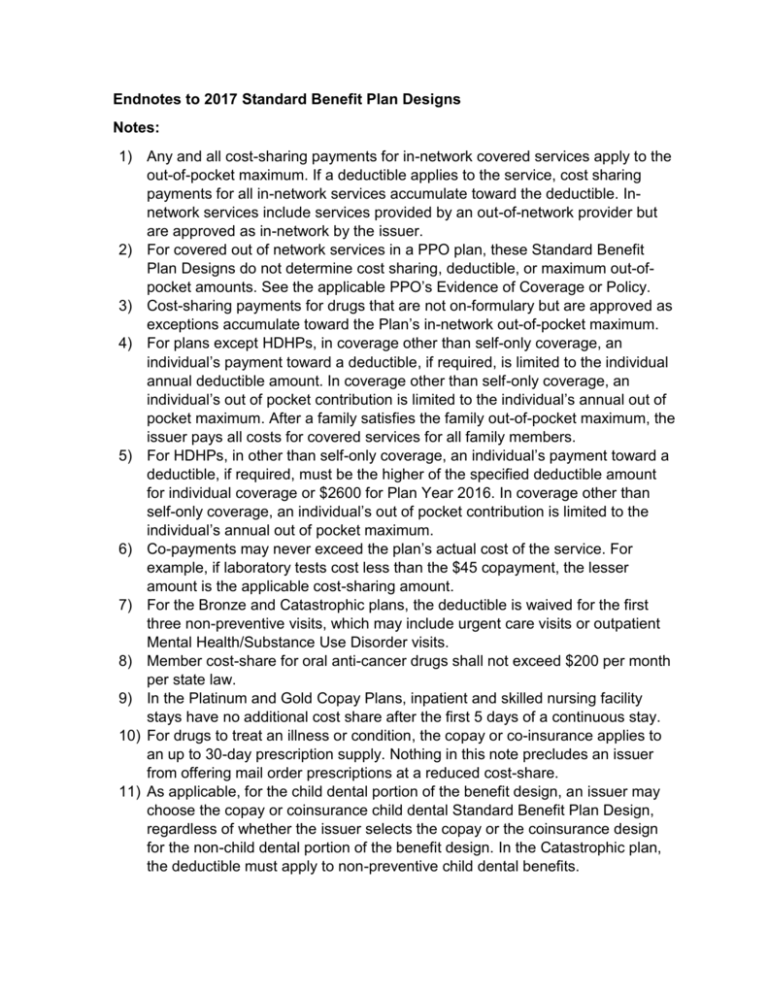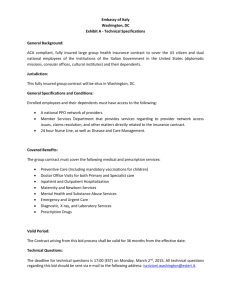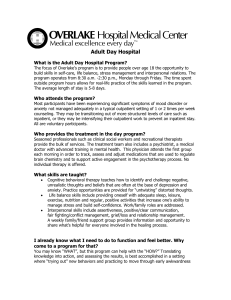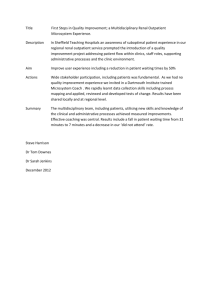Endnotes to 2017 Standard Benefit Plan Designs (Draft)
advertisement

Endnotes to 2017 Standard Benefit Plan Designs Notes: 1) Any and all cost-sharing payments for in-network covered services apply to the out-of-pocket maximum. If a deductible applies to the service, cost sharing payments for all in-network services accumulate toward the deductible. Innetwork services include services provided by an out-of-network provider but are approved as in-network by the issuer. 2) For covered out of network services in a PPO plan, these Standard Benefit Plan Designs do not determine cost sharing, deductible, or maximum out-ofpocket amounts. See the applicable PPO’s Evidence of Coverage or Policy. 3) Cost-sharing payments for drugs that are not on-formulary but are approved as exceptions accumulate toward the Plan’s in-network out-of-pocket maximum. 4) For plans except HDHPs, in coverage other than self-only coverage, an individual’s payment toward a deductible, if required, is limited to the individual annual deductible amount. In coverage other than self-only coverage, an individual’s out of pocket contribution is limited to the individual’s annual out of pocket maximum. After a family satisfies the family out-of-pocket maximum, the issuer pays all costs for covered services for all family members. 5) For HDHPs, in other than self-only coverage, an individual’s payment toward a deductible, if required, must be the higher of the specified deductible amount for individual coverage or $2600 for Plan Year 2016. In coverage other than self-only coverage, an individual’s out of pocket contribution is limited to the individual’s annual out of pocket maximum. 6) Co-payments may never exceed the plan’s actual cost of the service. For example, if laboratory tests cost less than the $45 copayment, the lesser amount is the applicable cost-sharing amount. 7) For the Bronze and Catastrophic plans, the deductible is waived for the first three non-preventive visits, which may include urgent care visits or outpatient Mental Health/Substance Use Disorder visits. 8) Member cost-share for oral anti-cancer drugs shall not exceed $200 per month per state law. 9) In the Platinum and Gold Copay Plans, inpatient and skilled nursing facility stays have no additional cost share after the first 5 days of a continuous stay. 10) For drugs to treat an illness or condition, the copay or co-insurance applies to an up to 30-day prescription supply. Nothing in this note precludes an issuer from offering mail order prescriptions at a reduced cost-share. 11) As applicable, for the child dental portion of the benefit design, an issuer may choose the copay or coinsurance child dental Standard Benefit Plan Design, regardless of whether the issuer selects the copay or the coinsurance design for the non-child dental portion of the benefit design. In the Catastrophic plan, the deductible must apply to non-preventive child dental benefits. 12) Cost-sharing terms and accumulation requirements for non-Essential Health Benefits that are covered services are not addressed by these Standard Benefit Plan Designs. 13) Mental Health/Substance Use Disorder Outpatient Items and Services include post-discharge ancillary care services and other outpatient support services, which may be provided as part of the offsite recovery component of a residential treatment plan. 14) Residential substance abuse treatment that employs highly intensive and varied therapeutics in a highly-structured environment and occurs in settings including, but not limited to, community residential rehabilitation, case management, and aftercare programs, is categorized as substance use disorder inpatient services. 15) Specialists include physicians with a specialty as follows: allergy, anesthesiology, dermatology, cardiology and other internal medicine specialists, neonatology, neurology, oncology, ophthalmology, orthopedics, pathology, psychiatry, radiology, any surgical specialty, otolaryngology, urology, and other designated as appropriate (28 CCR § 1300.51(I)(1)). 16) The Other Practitioner category may include Nurse Practitioners, Certified Nurse Midwives, acupuncture practitioners, Registered Dieticians and other nutrition advisors and other practitioners included in 28 CCR § 1300.67(a)(1). Nothing in this note precludes a plan from using another benefit category for a service provided by one of these practitioners. 17) The Outpatient Visit line item within the Outpatient Services category includes but is not limited to the following types of outpatient visits: outpatient chemotherapy, outpatient radiation, outpatient infusion therapy and outpatient dialysis and similar outpatient services. 18) For inpatient services, the inpatient physician/surgeon fee shall apply for any physician who bills separately from the facility. The cost share for an office visit shall apply for a visit to the member in an inpatient setting by the member’s primary care physician or specialist. Fees for hospitalists that are affiliated with the facility and are involved in the member’s care during an inpatient stay shall be included in the facility fee. For skilled nursing facility services, only a primary care visit copay or specialist visit copay may be applied if the member’s primary care physician or specialist provides a visit to the member in the facility. All other physician charges shall be included under the member cost share for SNF services and shall not be applied as a separate charge to the member. 19) Cost-sharing for services subject to the federal Mental Health Parity and Addiction Equity Act (MHPAEA) may be different but not more than those listed in these standard benefit plan designs if necessary for compliance with MHPAEA. 20) Treatment for autism and pervasive developmental disorder is covered under Mental/Behavioral health outpatient services. 21) Drug tiers are defined as follows: Tier 1 2 3 4 Definition 1) Most generic drugs and low cost preferred brands. 1) Non-preferred generic drugs or; 2) Preferred brand name drugs or; 3) Recommended by the plan's pharmaceutical and therapeutics (P&T) committee based on drug safety, efficacy and cost. 1) Non-preferred brand name drugs or; 2) Recommended by P&T committee based on drug safety, efficacy and cost or; 3) Generally have a preferred and often less costly therapeutic alternative at a lower tier. 1) Food and Drug Administration (FDA) or drug manufacturer limits distribution to specialty pharmacies or; 2) Self administration requires training, clinical monitoring or; 3) Drug was manufactured using biotechnology or; 4) Plan cost (net of rebates) is >$600. 220) Plan formularies must include at least one drug in Tiers 1 or 2 or 3 if all FDAapproved drugs in the same drug class would otherwise qualify for Tier 4 and at least 3 drugs in that class are available as FDA-approved drugs. 22) Issuers must comply with 45 CFR Section 156.122(d) dated February 27, 2015 which requires the health plan to publish an up-to-date, accurate and complete list of all covered drugs on its formulary list including any tiering structure that is adopted. 23) A plan’s formulary must include a clear written description of the exception process that an enrollee could use to obtain coverage of a drug that is not included on the plan’s formulary. 24) An issuer may offer plans with two in-network facility tiers, provided the lowestcost tier network (Tier 1) complies with the cost-sharing requirements in the standard benefit plan design and meets state network adequacy and timeliness standards as applied by the applicable regulator. Further, the issuer must demonstrate that the two in-network facility tiers are in the best interest of the consumer as determined by Covered California on a case-by-case basis, based on premium stability, price, quality, choice and value. For non-Qualified Health Plans, the applicable regulator will review. 25) The health issuer may not impose a member cost share for Diabetes Education which is defined as covered health education programs, which may include programs provided online and counseling over the phone; individual counseling when the office visit is solely for health education; and covered health education materials. Health education provided during an outpatient consultation or exam shall have no additional cost share beyond the cost share already required for the visit. 26) The health issuer may not impose a member cost share for Diabetes SelfManagement which is defined as services that are provided for diabetic outpatient self-management training, education and medical nutrition therapy to enable a member to properly use the devices, equipment and supplies, and any additional outpatient self-management training, education and medical nutrition therapy when directed or prescribed by the member’s physician. This includes but is not limited to instruction that will enable diabetic patients and their families to gain an understanding of the diabetic disease process, and the daily management of diabetic therapy, in order to avoid frequent hospitalizations and complications. These are mandated covered services under HSC § 1367.51 and CIC § 10176.61.




